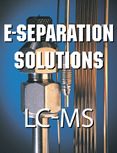Technology Forum: LC-MS
This month Chromatography Online's Technology Forum looks at the topic of LC-MS and the trends and issues surrounding it. Joining us for this discussion is Scott Berger of Waters Corporation, Graham McGibbon of Advanced Chemistry Development, Inc. (ACD/Labs), Bob Classon of Shimadzu Scientific Instruments, Inc., and Alexander Shaw, Ph.D of Hitachi High Technologies America, Inc.

Hyphenated techniques continue to drive both lab research and revenue growth in the field of chromatography, and nowhere is this more apparent than in the development of liquid chromatography-mass spectrometry. Once seen as a far-off, futuristic technique, LC-MS is now a laboratory staple and has accelerated the pace of scientific advancement dramatically. Even practitioners without a spectroscopic background are now making regular use of LC-MS instrumentation, as techniques and instruments become more user-friendly every day.
This month, E-Separations Solutions' Technology Forum looks at the topic of LC-MS and the trends and issues surrounding it. Joining us for this discussion are Scott Berger of Waters Corporation, Bob Classon of Shimadzu Scientific Instruments, Inc., Alexander Shaw, Ph.D of Hitachi High Technologies America, Inc, and Graham McGibbon of Advanced Chemistry Development, Inc. (ACD/Labs)
1. What trends do you see emerging in LC-MS?
Berger: As LC did many years ago, MS is starting to transition out of groups with pure analytical focus, and seeing broader application in groups producing and studying organic and biomolecules. Along the way, both entry level and higher-end MS technologies have become significantly more robust. My company's focus going forward is producing quadrupole and time-of-flight (TOF) products where the core tasks (startup, calibration, QC/suitability, and maintenance checks) are undertaken by the LC-MS system rather than the operators of the system.
Classon:Recent trends have been focused on higher information content, faster analyses, improved mass accuracy, and separations of more complex mixtures using a combination of techniques. For biological samples, for example, this involves more structural identification capability using MSn along with higher mass accuracy and high-speed polarity switching, along with faster scanning capabilities. Analysis of ever more complex samples in ever faster ways is driving both hardware and software developments.Overall, there is a need for simplification of the workflow for structural identification to bring the power of LC-MS to more chromatographers.
Shaw: A continuation of the move towards more flexible and versatile hybrid instruments. Q-TOF's and Trap-TOF's seem to be very popular right now, because they maximize the advantages of different mass analyzers while minimizing the disadvantages.Novel fragmentation technologies, such as ECD, ETD, and IRMPD continue to become more accessible to the general population, rather than just a few specialized mass-spectrometry labs.On the chromatography side, both nanoscale and multi-dimensional liquid chromatography technologies are continuing to mature into stable commercial platforms.In terms of proteomics workflows, there is a movement away from the peptide-centric approach towards intact protein analysis. Examples of this include top-down and middle-down proteomics workflows.Metabolomics, of course, is continuing to rise in popularity.
McGibbon:Converting LC-MS data into information at faster rates is an ever present challenge that stimulates improvements in data processing and interpretation capabilities. One emerging trend for LC-MS is for software to determine molecular formulas more reliably and easily for any peaks in a mass spectrum or entire datasets, especially in conjunction with isotope analysis as well as accurate mass data obtained from TOF (Q-TOF, Trap-TOF), Orbitrap, and FTICR hardware.
2. What is the future of LC-MS?
Berger: What are regarded as high-end capabilities today will become the universal detector technologies of tomorrow. Even today, single quadrupole mass spectrometry systems are seen by many users as a generic detector for an LC or UHPLC inlet. It will not be much longer until accurate mass capable MS technologies reach this same level of general application.
Classon:With the sensitivity and dynamic range of LC-MS, it will continue to be the detector of choice for many HPLC applications, even more than it is already today. The need for quantitative results at ever lower levels, such as the analysis of pharmaceuticals in surface water and drinking water, and the need to identify more contaminants and impurities in foods and pharmaceuticals, will keep LC-MS at the forefront for a long time. Forensics and clinical applications are rapidly adopting LC-MS instruments for many routine applications. For many types of clinical analyses, the cost per test is low enough and speed using LC-MS is fast enough that test panel assays for high-throughput tests are more likely to be performed by LC-MS than by conventional means. Multiple analytes can often be measured routinely in two minutes or less. Many new labs have been set up just to take advantage of the power and speed that LC-MS provides.
Shaw:As mentioned above, instrumentation will move towards more flexible and powerful hybrid platforms. Sensitivity and resolution will always be areas that can be improved upon for the analysis of complex peptide mixtures.
McGibbon:I expect that in the future we will see more highly automated workflow-based LC-MS solutions, including instrument methods and structure-based data processing. Consequently, in the future metabolite identification will require only limited user input to provide predicted structure assignments for review and databasing. Small molecule biomarker discovery and trace impurity analysis, especially of potentially toxic compounds, should be facilitated by software algorithms that can extract components or at least features from LC-MS datasets. As these advanced algorithms get amalgamated into packages that incorporate significant file management options they will become more comfortable for chromatographers to use and the upshot will be extremely powerful systems for automated method development based on LC with UV and MS detection.
3. What is the LC-MS application area that you see growing the fastest?
Berger: The biopharmaceutical industry has adopted both intact protein LC-MS and peptide mapping LC-MS as fundamental tools for initial characterization of their complex products. We are now seeing much stronger applications of LC-MS earlier in the process as companies employ greater analytics to empower more rigorous expression clone selection processes. We are also seeing much more demand for rapid biotherapeutic screening capabilities later in the development process as PAT and quality by design (QbD) initiatives, and process improvement groups are generating ever increasing volumes of samples for analysis. At the same time, companies are asking their analytical groups to meet these challenges through greater efficiencies rather than through vast increases in headcount or capital outlays.
Classon:It is difficult to pick out just one area right now because almost every area is seeing new applications show up so often. LC-MS is obviously still strong in traditional pharmaceutical, organic synthesis, forensics, environmental and the life science markets. The life science "omics" type applications, such as proteomics, glycomics, lipidomics, and cellomics are pushing the boundaries of what can be done with different technologies, especially LC-MS.A relatively new area for LC-MS is in fuel research including biofuels, biodiesel, and fermentation monitoring. This is an area receiving a lot of funding, so it is going to drive instrument development also.
Shaw:Metabolomics.Triple-quad MRM analysis of protein abundance.
McGibbon: LC-MS in the area of toxicology has considerable growth potential since there is increasing interest in the fate and distribution of biologically active compounds in the environment (ecotoxicology). Chris Hopley of LGC is doing interesting work to determine if building up libraries of searchable collision induced dissociation mass spectra irrespective of which mass analyzer system is used to acquire them is really going to become a possibility.
4. What obstacles stand in the way of LC-MS development?
Berger: There have not been any fundamental gains in MS dynamic range of detection for many years. Except for some custom-developed MS platforms, all the vendors still contend with the same three to four orders of dynamic range for full scan MS operation.
Classon:For all the years of development of LC-MS instruments, there are still primary losses of ions in the transfer from the atmospheric pressure source region to the first vacuum stage. It has been shown that 99.99% of all losses occur in this area. Although most LC-MS optical developments over the past few years have resulted in small improvements either in ion production, or in ion transfer within the vacuum regions of the instrument, very little has been done to reduce the losses in the transition between atmospheric pressure and the first vacuum stage of an LC-MS instrument. New optical designs and new focus elements are needed to minimize these losses in order to improve sensitivity for the next generation of instruments.
Shaw:Data analysis continues to be the bottleneck of any high-throughput LC-MS experiment. Thousands of spectra are generated. Protein identification can be done in a relatively automated and straight-forward manner. Conversely, more challenging problems, such as PTM characterization, become difficult at this scale. Currently available software packages can't seem to keep up with the sheer magnitude of data that modern instruments generate.
McGibbon: One of two problems in LC-MS that will require significant developments to address and overcome is the constant concern of finding components that overlap or co-elute, particularly underneath the parent compound or active pharmaceutical ingredient. The other is to develop means to reconcile peaks detected (or not) in multiple detector traces. Also, cost cutting mentality may pressure vendors, but induce even closer relationships between hardware and software providers.
5. What was the biggest accomplishment or news in 2007 for LC-MS?
Classon:Although there were several new technical introductions in the past year, including such items as remote sampling and IMS and DMS improvements, my feeling is that the biggest improvements have really been in terms of getting faster results, from single quads, triple quads, and hybrid MS systems. This is being driven by many different applications, including those for clinical monitoring and protein analysis. Scans are getting faster and operation is allowing more functions in less time - eg, polarity switching. Accurate mass capabilities are improving for nearly all types of mass spectrometric instruments.
Shaw:The increase in accessibility of previously difficult-to-implement technologies, such as ECD, ETD, and nanoscale flow chromatography. These technologies are now maturing into stable commercial products, allowing non-specialists access to technologies available only to a few specialized laboratories. This will vastly increase the scope of problems that mass spectrometry is being used to address, especially in the fields of biochemistry and biotechnology.
McGibbon: Among the accomplishments involving LC-MS in 2007, two that stand out to me in particular were the nuclear pore complex elucidation using invaluable contributions of Chait and co-workers [1] and the draft of the human metabolome reported by Wishart and collaborators [2].
[1] Alber F, Dokudovskaya S, Veenhoff LM, Zhang W, Kipper J, Devos D, Suprapto A, Karni-Schmidt O, Williams R, Chait BT, Sali A, Rout MPThe molecular architecture of the nuclear pore complex.
[2]Nature 450, 695-701 (29 November 2007). doi:10.1038/nature06405 Wishart DS, Tzur D, Knox C, Eisner R, Guo AC, Young N, Cheng D, Jewell K, Arndt D, Sawhney S, Fung C, Nikolai L, Lewis M, Coutouly MA, Forsythe I, Tang P, Shrivastava S, Jeroncic K, Stothard P, Amegbey G, Block D, Hau DD, Wagner J, Miniaci J, Clements M, Gebremedhin M, Guo N, Zhang Y, Duggan GE, Macinnis GD, Weljie AM, Dowlatabadi R, Bamforth F, Clive D, Greiner R, Li L, Marrie T, Sykes BD, Vogel HJ, Querengesser L.HMDB: the Human Metabolome Database.Nucleic Acids Res. 35(Database issue), D521-6 (Jan 2007). doi: 10.1093/nar/gkl923

Common Challenges in Nitrosamine Analysis: An LCGC International Peer Exchange
April 15th 2025A recent roundtable discussion featuring Aloka Srinivasan of Raaha, Mayank Bhanti of the United States Pharmacopeia (USP), and Amber Burch of Purisys discussed the challenges surrounding nitrosamine analysis in pharmaceuticals.
Advances in Non-Targeted Analysis for PFAS in Environmental Matrices
March 27th 2025David Megson from Manchester Metropolitan University in Manchester, UK, spoke to LCGC International about the latest developments in non-targeted analysis (NTA) of per- and polyfluoroalkyl substances (PFAS) in environmental matrices based on a recent systematic review paper he has collaboratively published (1).







